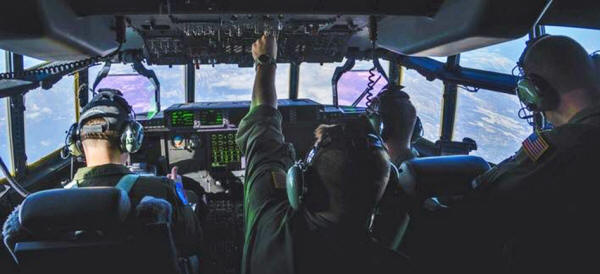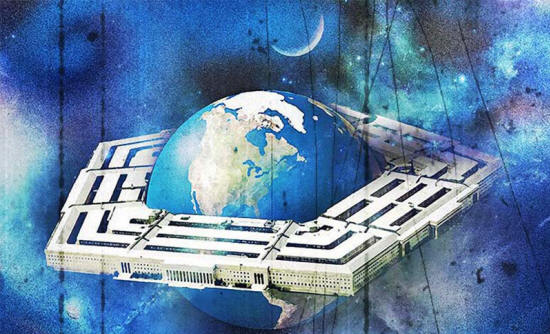|
from
DefenseOne website
Staff
Sgt. David Owsianka its technological and doctrinal efforts towards a perpetual, networked presence that enables operations and awareness anywhere in the world.
When the Royal Navy's new steam-powered ships emerged victorious from the First Opium War in 1842, one British newspaper could barely contain itself:
One hundred years later, Wernher von Braun, a German engineer who'd been secretly whisked away to the United States, suggested a different approach:
As he put it,
Today, in the face of other nations' advances and area-denial strategies, the U.S. Department of Defense is looking for the next set of technological breakthroughs that will allow the military to engage,
But unlike steam engines or space stations, the technologies and supporting architectures that can actually establish omnipresence today are possible.
The strategy to regain our fighting edge has been called the Third Offset. But whether given this or some other name, one of its primary shortfalls is that it lacks a unifying concept.
Many believe the present approach is really just a set of technology investments and is too focused on futurist technologies. And some scholars have argued that it seems to have "no clear purpose or urgency."
Military, or operational, omnipresence is the answer to this dilemma.
Operational omnipresence is exactly what it sounds like:
It consists of three primary interconnected components:
It's the culmination of where you are, where you can be quickly, and awareness of what is occurring everywhere else.
In other words, operational omnipresence is superlative forward presence - a U.S. military preoccupation since at least World War II - accomplished by a variety of interacting means.
Execution of this concept is exceptionally difficult, but that's how competitive advantages are realized.
Making operational omnipresence a reality requires surmounting the tyrannies of time, distance, and information - the significant difficulties associated with operating across great distances and needing to be quick and sure-footed in doing so.
It can do so via its three essential components of presence: physical, virtual, and perceived.
Physical presence is the strategic positioning of military forces around the world such that they are always in relative proximity to contingencies. In addition to deploying ships and planes abroad, the U.S. military maintains more than 150,000 service members on 800 bases in 70 countries.
This is the most expansive military footprint of any nation, and accounts for more than 95 percent of the world's foreign bases.
Further, the current presidential administration has articulated its goal to increase physical presence in a recent executive order. When coupled with unmanned and autonomous vehicles and aircraft, physical presence is remains a U.S. strength.
But there will be gaps, and virtual presence can help fill them.
Previous conceptions of virtual presence have defined it as being physically nearby or having a passive presence via technology. But today, virtual presence exists where force can be applied quickly from a distance - within hours or even nanoseconds - and includes cyber, electronic, and space-borne warfare.
Whether moving at the speed of light from thousands of miles away to strike in cyberspace, reassuring allies and partner nations through the sharing of digital capabilities, or causing adversarial nations to adjust their decision calculus as these two things come fully online, virtual presence can be a true form of forward presence.
Perceived presence rounds out the operational omnipresence concept.
Perceived presence is the use of technology to collect information and monitor events occurring in places in which physical and virtual presence aren't possible.
Though it doesn't permit the application of force, the perception of being watched influences behavior - an insight that goes back to the concept of the panopticon introduced by 17th-century English philosopher Jeremy Bentham.
Today, cyber- and satellite-enabled surveillance, coupled with traditional forms of intelligence gathering and the ubiquity of the press and personal devices, means that a global electronic version of the panopticon is possible.
The strategic use of acquired information could be employed to influence the decisions of competitor nations. What was thought to be in secrecy is now under a spotlight. From that point forward, this nation would assume it is being watched.
This, too, is a form of presence, and the essence of perceived presence.
With physical, virtual, and perceived presence established, operational omnipresence is possible. Offsetting the gains of other nations' militaries, then, is not just about more ships and planes, more cyber capabilities, or a vast surveillance network.
It is all these things in an interconnected, interdependent system that requires fundamental transformations of the interactions between technologies, organizations, and personnel.
Naturally, the heaviest lift is the necessity for near-real-time analysis of massive amounts of information.
Technological advances mean that conflict can occur at machine-speed, and the information generated and gathered by the multitude of weapons, unmanned and autonomous systems, digital communications, and sensors can quickly overwhelm the ability to process and respond to it.
The networked interdependence of every element of presence and the information required to support it,
Gen. David Goldfein, the current Chief of Staff of the U.S. Air Force, believes competitive advantage depends on,
This means that information systems will need to bear more of the burden to review information, learn from it, and make immediate recommendations to decision-makers - and, in some cases where the risk to life or the mission is at stake, to take action itself.
To enable this, operational omnipresence requires a common operating system, an architecture that supports real-time information exchanges between every component in the network of systems.
Supercomputing power is necessary. Artificial intelligence across the system is critically important. Human-machine pairing is vital.
They are the means by which all of the data can be reviewed and analyzed, transforming presence from three sectored capabilities into a synthetic organism that can sense and respond to the environment around it with human direction.
The U.S. military has crossed a technological Rubicon.
Technological advances and their military applications cannot be undone. Operational omnipresence seems to be the logical next step in the progression of the changing character of warfare.
The strategy to recover lost ground in our fighting edge over other nations needs this sort of unifying concept to ensure technological and architectural innovations are working toward the same goal.
Without the vision of operational omnipresence to bind disparate efforts into a cohesive strategy, the U.S. military runs the risk of further erosion in its military technological advantage.
The future of conflict, like its past, requires dominion over the time, distance, and information associated with operations.
The Department of Defense is making progress in this regard, but it should continue adapting, innovating, and evolving until operational omnipresence is achieved.
|



